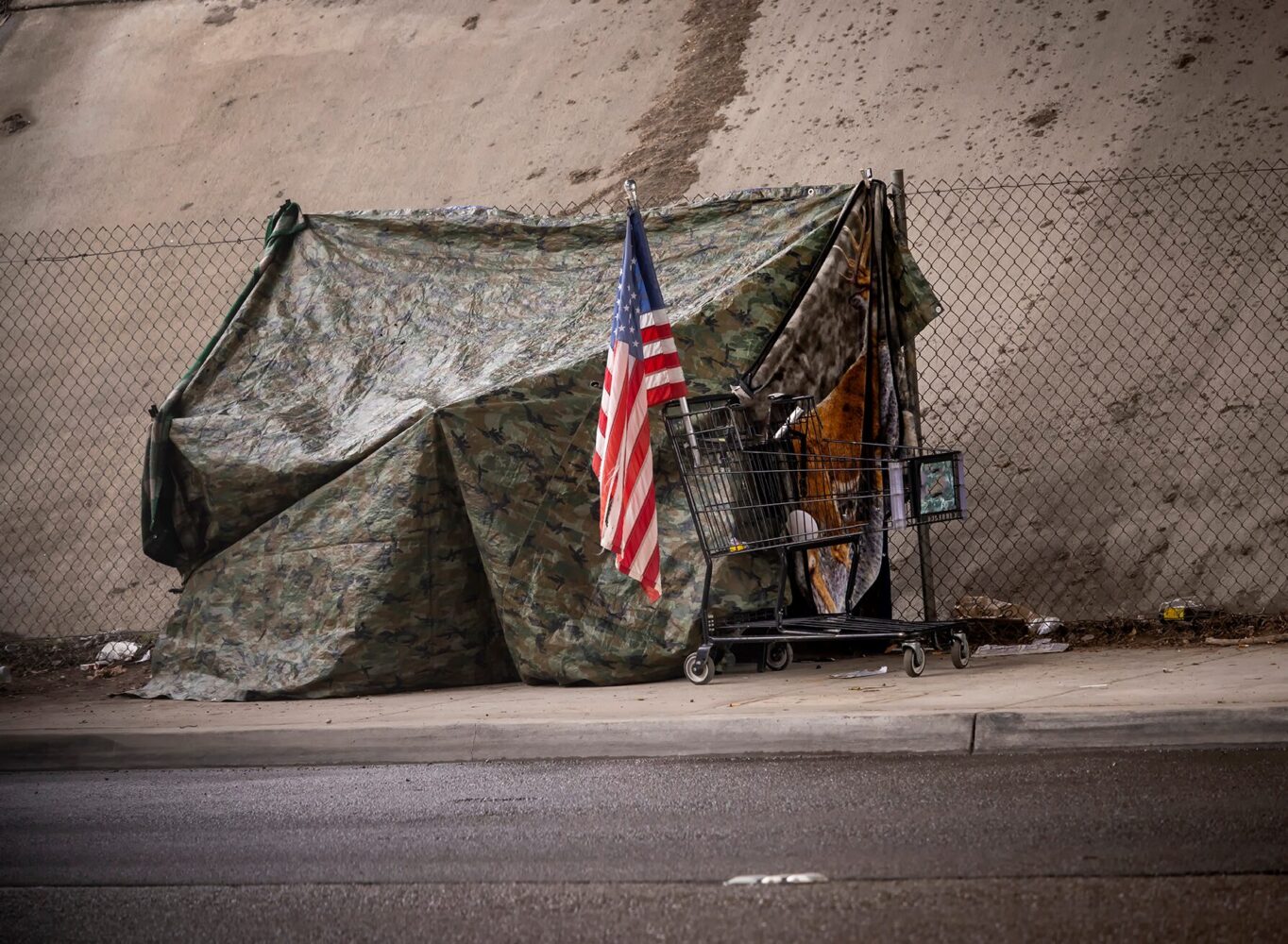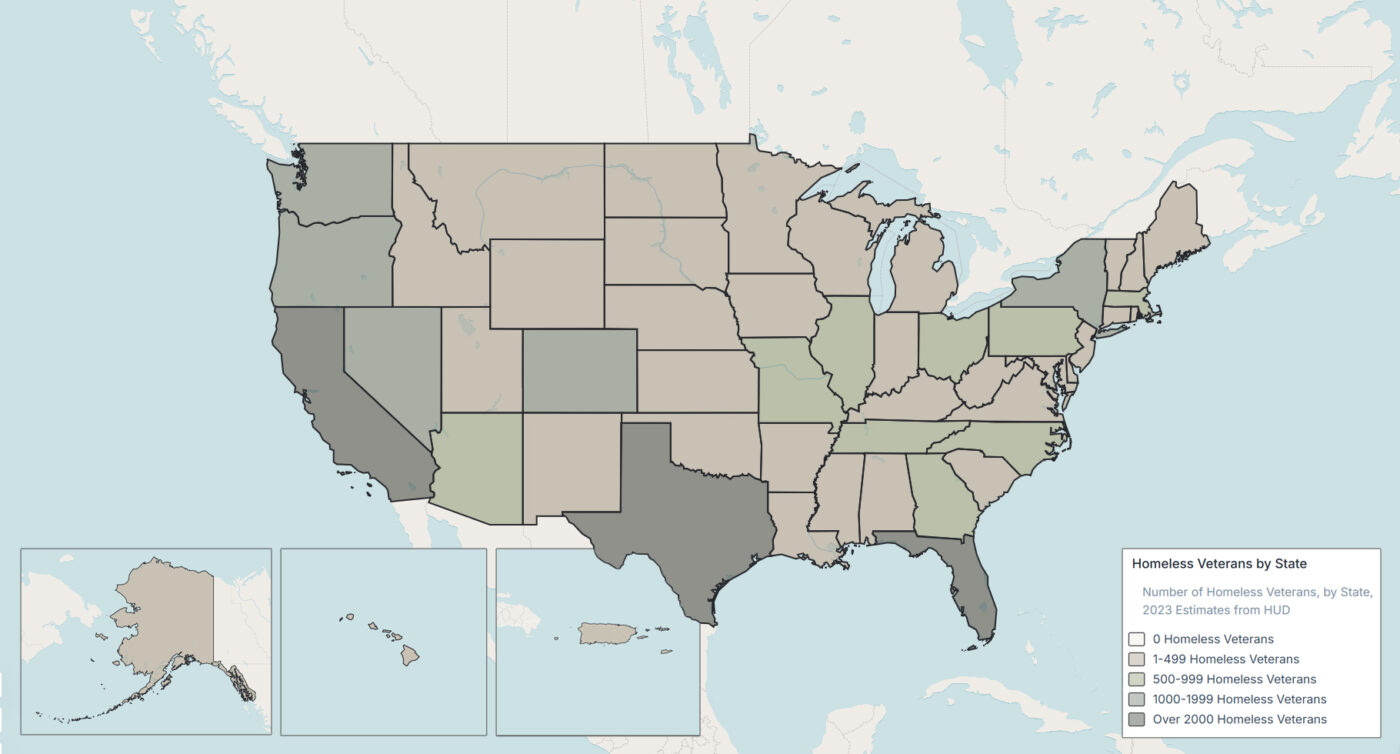Veteran Homelessness is a National Crisis
Every veteran deserves more than our gratitude—they deserve a safe place to call home. Our research sheds light on the barriers and solutions to ending veteran homelessness.
At least 33,000 veterans are homeless today. That’s a national crisis.
Veterans deserve more than our gratitude—they deserve a safe place to call home. But when one out of every few hundred veterans is without one, we’re failing those who gave so much to our country.
We Owe Them More: Confronting the Reality of Veteran Homelessness
Our research sheds light on the state of homelessness in 2025, exploring root causes, trends, barriers, and solutions to ending veteran homelessness. We evaluate the effectiveness of current intervention programs, and propose evidence-based solutions carried out by nonprofit organizations at the community level. Defeating this issue requires effort and coordination from local communities all the way to government leaders in Washington, DC.
Progress is possible – we’ve already seen it as levels have come down over the last decade.
But too many are still without homes. After making significant progress from 2011 to 2016, the number of veterans experiencing homelessness has remained largely flat over the past decade. States and cities across the U.S. have counted 33,000 homeless veterans, and that’s just the number we know. Many more may remain unseen and unsupported.

The missing data in 2021 is due to COVID-19 disruptions. Citing COVID-19 concerns, many communities did not conduct a full Point-in-Time count.

Data Gaps and Invisible Populations
Numbers don’t tell the whole story
The Point-in-Time (PIT) Count is the federally recognized standard for estimating homelessness in the United States. It’s an annual, nationwide effort to count the number of people experiencing homelessness on a single night in January. Conducted by local communities with support from the U.S. Department of Housing and Urban Development (HUD), the PIT Count provides a snapshot of homelessness—including veterans—by collecting data on individuals living in shelters, transitional housing, or in unsheltered locations like streets, parks, and abandoned buildings. This data helps inform policy, allocate resources, and track progress toward ending homelessness.
While it reveals much, the PIT Count misses many who are:
- Hidden or in remote areas
- Temporarily staying with friends or in motels
- Unwilling to disclose veteran status
- Parents (especially women) avoiding visibility to protect their children from child welfare systems

Where ARE Most Homeless Veterans?
Veteran homelessness is a national issue, but some states carry a disproportionate share of the burden. Factors like high housing costs, limited affordable housing stock, non-interventionist policies, which limit government involvement in housing and social services, and gaps in local support services contribute to these regional disparities.
The highest numbers of homeless veterans are concentrated in:
| State | Total Number Homeless Veterans | # Homeless Veterans per 10,000 Veterans in State | Rank by Homeless Veterans per Total Veterans in State |
| California | 9,310 | 72 | #1 |
| Florida | 2,333 | 18 | #13 |
| Texas | 1,837 | 13 | #23 |
| Washington | 1,780 | 33 | #4 |
| Oregon | 1,407 | 59 | #2 |
| New York | 1,098 | 17 | #17 |
| Nevada | 1,094 | 52 | #3 |
The Western states, which rank highest for number of homeless veterans per total veterans, are marked by limited affordable housing stock and non-interventionist policies.
But while the picture looks rosier in rural states, it may just be that it’s harder to count homelessness in such places. States with more rural areas and less dense populations (e.g. Mississippi, North Dakota, Iowa, West Virginia and Alabama) have a greater challenge than cities to cover all areas and count unhoused individuals in the PIT count. The actual number of veterans experiencing homelessness may be higher than reported in those states despite efforts to identify those in need of support.
Let that sink in: Veterans in rural America are almost impossible to count, let alone serve—yet they suffer all the same.
Thus, the PIT count represents a baseline or minimum, not a full accounting—offering a glimpse of the problem rather than its true scale, especially in rural or hard-to-reach communities where homelessness is more easily hidden.
In addition to geographic blind spots, some populations are consistently missed—not just because of where they are, but because outreach teams struggle to find or engage them. Women and Indigenous veterans are among those most affected, often unseen in official data, yet vulnerable to homelessness.
Women Veterans Homelessness on the Rise
Women now make up more than 10% of the veteran homeless population—rising significantly since pre-COVID levels. In 2024, 3,329 women veterans were homeless, down slightly from a high of nearly 4,000 the previous year.
Many face unique challenges, including military sexual trauma, domestic violence, and caregiving responsibilities, making targeted support essential to preventing and ending homelessness among women veterans.
They may also be undercounted in official data, as many avoid shelters or stay temporarily with friends or family to protect themselves and their children, making them less visible to outreach teams.
The missing data in 2021 is due to COVID-19 disruptions. Citing COVID-19 concerns, many communities did not conduct a full Point-in-Time count.
Indigenous Veterans Disproportionately Affected
Native American and Indigenous veterans are the least likely to be sheltered (nearly 6 out of 10 are unsheltered, compared to 4 in 10 homeless veterans overall) and are often overlooked in resource allocation and program design because they are frequently underrepresented in data, underserved by mainstream systems, and reside in areas with limited outreach infrastructure.
They face some of the highest rates of homelessness among veterans, driven by systemic barriers, historical trauma, and limited access to culturally competent services. Many live in rural or tribal areas where PIT Count efforts are sparse or inconsistent, making them one of the most invisible veteran populations in the national conversation on homelessness. Addressing these disparities requires intentional outreach and tailored support.
The Cost of Incomplete Data
Understanding who is missing from the data is just as important as understanding who is counted. These gaps limit our ability to fully grasp the scale of the crisis and design interventions that reach everyone in need. If entire groups—like rural veterans, women, or Indigenous communities—remain invisible in the numbers, they risk remaining invisible in the solutions. A more complete picture is essential to crafting policy and support systems that leave no veteran unsupported.
Root Causes of Veteran Homelessness
Veteran homelessness doesn’t begin with the loss of housing—it often begins with poverty. Many veterans face economic instability after service due to limited job opportunities, physical or mental health challenges, or difficulty accessing benefits. While federal programs exist to support transitioning service members, too many fall through the cracks, entering civilian life without the financial cushion, job training, or healthcare access they need.
Poverty among veterans is also linked to broader systemic issues:
- Rising housing costs
- Wage stagnation
- Racial inequities
- Gaps in behavioral health services
These factors intersect and compound, increasing the risk of homelessness for already vulnerable veterans. Addressing homelessness without addressing poverty is like treating symptoms without tackling the disease. A sustainable solution must focus upstream—on income security, affordable housing, access to care, and social reintegration.
One particularly under-recognized factor is relational poverty—a lack of access to networks of care, trust, and support that can buffer against personal crises like losing a job, illness, or eviction.
Many veterans become disconnected from family, friends, and community due to trauma, mental illness, or addiction. These experiences can erode trust and social ties, making it harder to form or maintain the relationships that often keep people housed.
Solutions That Seek the Uncounted and Address Root Causes
It’s time to stop managing this problem and start solving it
Homelessness has remained largely flat over the past decade even as federal spending on homelessness has increased four-fold during the past 15 years.
Nearly $3.2 billion was allocated to veteran homelessness programs in the FY 24 budget – that’s about $100,000 per person per year.
Yet due to the “hidden” nature of unhoused individuals, and the complex factors often responsible for veteran homelessness (such as trauma, substance abuse, and mental health challenges), supportive services don’t always reach those in need when delivered through centralized programs.

So what is more effective?
- Addressing trauma through mental health services and trauma-informed care in other areas
- Investing in relationship-based services, such as mentoring or long-term case managers
- Incorporating community through peer support groups or neighborhood engagement
- Focusing on prevention to avoid the relational poverty cycle before it begins
It’s time to rethink the Veteran Homelessness strategy. Federal spending is essential, but it’s not the only tool we need to prevent homelessness and help those recovering from it.
Community Organizations Best Equipped to Serve
Veterans Didn’t Serve Alone. They Shouldn’t Suffer Alone.
Funding community-based services that are designed and delivered at the local level is not only more effective—it’s a better use of the VA budget. These organizations are closest to the need and best equipped to address the complex, persistent drivers of veteran homelessness that national programs often overlook.
Local providers offer more than housing. They deliver comprehensive, wraparound support that tackles both immediate needs and the deeper social and economic forces that put veterans at risk in the first place, like:
- Substance use
- Mental health challenges
- Disability
- Poverty
- Unemployment
- Financial instability
- Social isolation
Many also work to rebuild trust and community for veterans suffering from relational poverty—the breakdown of support systems that often accompanies trauma, addiction, or long-term isolation. Reconnecting veterans with networks of care is essential to preventing recurrence and supporting long-term recovery.
Local nonprofits build these relational networks every day. They form bonds, foster community, and earn trust in ways that large-scale programs often cannot. Prevention doesn’t happen in isolation—it requires sustained investment in trusted, community-based partners who can engage veterans early, locally, and help them stay housed for the long term.
Here are a few veterans organizations providing unique and effective models of transformation:
Santa Barbara VA and Community Partners
In Santa Barbara, CA, Veteran homelessness has dropped 60% since 2020 as a result of collaboration between VA staff, county and city employees, local housing authorities and numerous partners working together to find permanent homes for Veterans in need.
Read moreYvette Jones
Housing homeless veterans takes more than a roof - it takes a united front. Unfortunately, the reality is, the community is not on the same page. While veterans are eligible for life-changing resources, the people who could help them most – social workers, case managers, human service professionals, family members, neighbors and even realtors – often lack the specialized training to guide them through the maze of veteran-specific benefits.
Read moreMighty Hero Homes
Mighty Hero Homes are designed in a base formation - not only to be familiar to veterans, but to foster a sense of community. Further, we don’t just want to see the community coming around veterans to help them; we want to see these veterans having an impact on their community and contributing positively to its transformation for generations.
Read moreBoulder Crest Foundation
All of the programs at Boulder Crest are built on the idea of teaching and training men and women who are struggling to transform their struggles into strength and achieve 'posttraumatic growth' in their lives.
Read moreLorem ipsum dolor sit amet, consectetur adipiscing elit. Donec convallis commodo dui ut ultricies. Proin feugiat faucibus orci. Etiam ultrices felis vel sem suscipit, sit amet cursus eros convallis. Ut consequat molestie varius. Mauris scelerisque ante nec auctor iaculis.
Donate TodayConclusion: A National Responsibility, A Local Opportunity
Veteran homelessness remains one of the most persistent and complex social challenges in the United States, reflecting the intersection of military service, mental health, economic hardship, and systemic barriers to support. But it’s not inevitable.
It’s the result of systems that fail to catch people when they fall—systems that overlook trauma, relational poverty, and economic insecurity until it’s too late. While we’ve made real progress over the last decade, tens of thousands of veterans remain without a home, and many more are hidden from view—particularly in rural areas, or among groups like women and Indigenous veterans whose experiences often go uncounted.
If we want to change that, we need to stop treating homelessness as simply a housing problem, and start addressing it as a community problem—rooted in disconnection, trauma, and poverty. That means building up local, relationship-based responses that address the whole person. It means funding the people and organizations that meet veterans where they are and stay with them for the long haul.
What You Can Do
Veteran homelessness is solvable—but only if we act. Here’s how you can help:
- Support local nonprofits that provide wraparound services and relationship-based care to veterans in your community.
- Advocate for smarter funding that prioritizes community-based solutions, not just large-scale programs.
- Push for better data and outreach to ensure that women, Indigenous veterans, and rural populations are seen and counted.
- Talk about relational poverty. Elevate the conversation around what really keeps people housed—and what happens when those networks break down.
Veterans didn’t serve alone. They shouldn’t have to recover alone. Let’s build a system worthy of their sacrifice—one that offers not just shelter, but connection, stability, and a path home.


